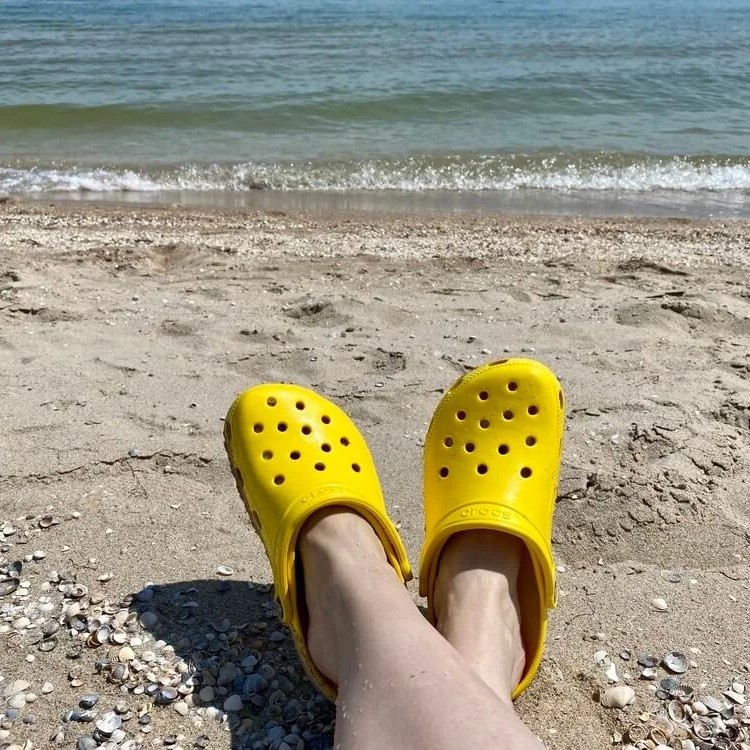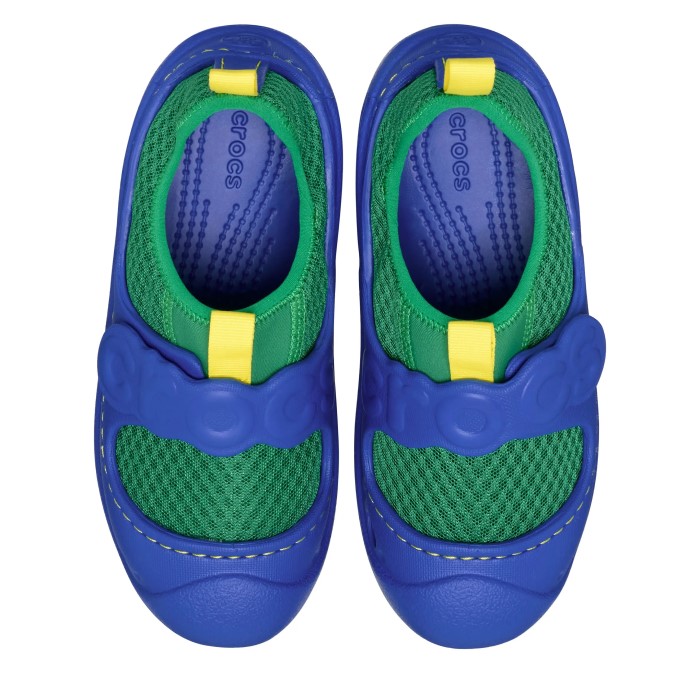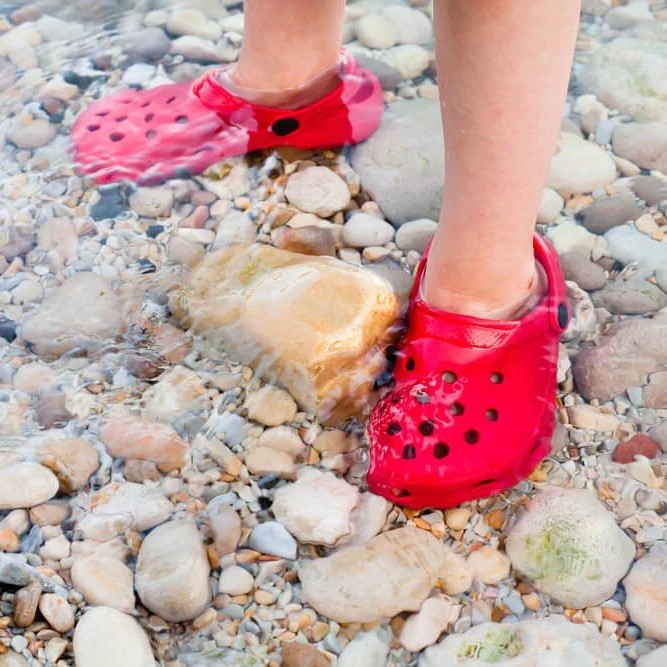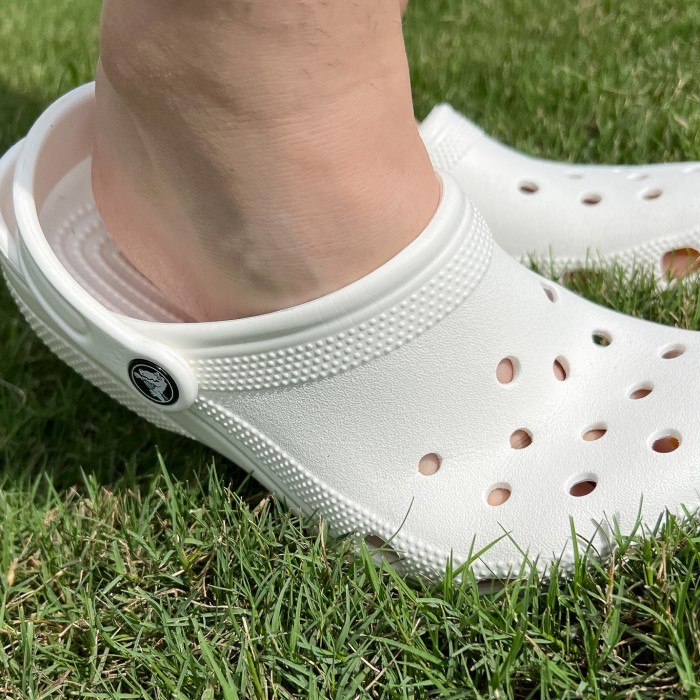What Are Crocs Water Shoes?
Crocs water shoes are a popular choice for footwear in wet environments. Known for their distinct design, these shoes are lightweight, comfortable, and versatile. They are designed to handle water exposure while providing excellent support and protection for your feet.

Design and Materials
Crocs water shoes are made from a proprietary material called Croslite. This material is soft, durable, and non-absorbent, making it ideal for wet conditions. The shoes often feature perforated uppers, allowing water and air to flow freely. This ensures quick drying and prevents water from pooling inside. Additionally, the soles are slip-resistant, providing excellent grip on wet and slippery surfaces.
The design of Crocs water shoes prioritizes simplicity and functionality. They usually have a roomy fit, making them comfortable for extended wear. The adjustable straps on some styles add an extra layer of security, ensuring they stay securely on your feet during activities.
Types and Styles Available
Crocs offer a variety of water shoe styles to cater to different needs. Classic clogs are the most recognizable, ideal for casual wear and water-based activities. For those who prefer more coverage, some styles resemble traditional sneakers but feature water-friendly materials.
Crocs also make sandals and flip-flops suitable for wet environments. These are lightweight and often have footbed cushioning for added comfort. There are also kid-friendly versions, offering bright colors and fun designs to appeal to children.
With these options, Crocs water shoes can meet the diverse needs of wearers. Whether for swimming, boating, or casual strolls, they cater to nearly every occasion involving water.
Benefits of Wearing Crocs as Water Shoes
Crocs water shoes are highly valued for their functionality and practicality in wet conditions. Their unique design and materials make them a reliable choice for various water-related activities. Let’s explore their benefits in detail.
Comfort and Ergonomic Features
Crocs water shoes are crafted for maximum comfort. The Croslite material provides exceptional cushioning for your feet. This material molds to your foot shape, enhancing ergonomic support and reducing strain. The roomy fit accommodates different foot sizes, making Crocs ideal for prolonged wear. Perforated designs increase breathability, keeping feet cool even in warm weather. Adjustable straps on some styles add security and ensure a snug fit during active movement.

Durability in Wet Environments
Crocs water shoes are highly durable, especially when exposed to wet surfaces. Croslite material is resistant to damage from water or salt exposure, prolonging their lifespan. Non-absorbent features ensure that Crocs repel water and dry quickly after use. Their slip-resistant soles provide excellent grip, reducing risks of falling on slippery surfaces. These features make Crocs reliable, even in challenging wet environments such as pools, rivers, or beaches.
Versatility for Different Activities
Crocs offer versatility for a variety of water-related and casual activities. They transition easily from wet to dry environments, allowing wearers to use them for boating or swimming. Their lightweight design makes packing Crocs convenient for traveling. Sandals and flip-flop styles are perfect for outdoor picnics or poolside relaxation. Hiking styles with higher coverage can handle water crossings without compromising comfort. These water shoes suit almost any occasion and provide flexibility during recreational pursuits.
Comparing Crocs to Traditional Water Shoes
Crocs water shoes and traditional water shoes each bring unique benefits to the table. Understanding their differences can help you choose the best footwear for specific activities.
Performance in Water-Based Activities
Crocs excel in water-based activities thanks to their lightweight and quick-drying design. Croslite material repels water, ensuring comfort during prolonged use. Their slip-resistant soles provide a firm grip on wet surfaces, reducing slipping risks.
Traditional water shoes are designed specifically for active water sports like kayaking and rafting. They provide better foot protection and grip in rougher environments. Their snug fit prevents debris from entering, offering more safety than Crocs for risky adventures.
For casual water use like walking or beach outings, Crocs are effective and convenient. When tackling intense water activities, traditional water shoes often outperform Crocs.
Fit and Support Differences
Crocs water shoes prioritize comfort with a spacious fit. This roomy design suits various foot shapes and enhances breathability. Adjustable straps on certain models allow wearers to secure the shoes easily.
Traditional water shoes often have a tighter fit, providing more support during water sports. Their snug design keeps them securely attached to your feet, even in fast-moving currents. However, this close-fitting style may not suit wearers who prefer extra room.
Crocs are better suited for casual use and relaxed activities. Traditional water shoes cater to wearers needing superior foot support during intense water conditions.
Cost and Value Considerations
Crocs water shoes are generally affordable and deliver versatile functionality for everyday water use. Their durability ensures long-term value, making them a cost-effective option.
Traditional water shoes often come at a higher price point due to specialized features. They are built for heavy-duty performance, which justifies the added cost. For wearers engaging in frequent water sports, this investment can be worthwhile.
Crocs offer excellent value for casual users. Traditional water shoes provide better value when tailored support and performance matter most.

Places and Activities Perfect for Crocs
Crocs are versatile, making them suitable for many wet and dry settings. Their design favors both casual and active use, offering functionality and comfort. Below are some ideal places and activities where Crocs excel.
Beach and Pool Use
Crocs water shoes are perfect for the beach and pool. Their non-absorbent Croslite material ensures quick drying. Perforations allow water and sand to escape easily, keeping feet comfortable. Slip-resistant soles provide stability on wet pool decks and sandy shores. Their lightweight build ensures easy wear, whether you’re lounging or exploring the beach.
Hiking with Water Crossings
Crocs are great for hikes involving streams or water crossings. Higher-coverage models shield feet from debris in shallow waters. Slip-resistant soles offer grip, reducing falls on slippery rocks. The adjustable straps ensure a secure fit during active movement. Lightweight hiking styles make Crocs easy to pack for outdoor adventures.
Casual Wear Around Wet Areas
Crocs transition smoothly from wet to dry environments. They’re excellent for activities like gardening, washing cars, or walking near fountains. Their comfortable fit and quick-drying features suit everyday wear near water. Whether running errands on rainy days or strolling near rivers, Crocs ensure convenience and reliability.
Pros and Cons of Using Crocs in Water
Crocs water shoes offer unique benefits and some limitations in wet environments. Understanding their pros and cons can help you make an informed choice.
Advantages in Wet and Dry Conditions
- Quick Drying: Crocs are made from non-absorbent Croslite material, ensuring they dry quickly after water exposure.
- Lightweight Design: Their lightweight construction makes them easy to wear for extended periods without discomfort.
- Slip-Resistant Soles: The soles provide excellent grip, reducing risks of slipping on wet surfaces.
- Versatility: Crocs transition seamlessly between wet and dry settings, making them ideal for casual use.
- Easy Maintenance: Cleaning Crocs is simple, as the material resists stains and requires minimal effort to wash.
- Comfortable Fit: The roomy fit and cushioned material offer comfort for prolonged wear in water.
- Affordable Choice: Crocs deliver good value for money, especially for casual and occasional water use.
Potential Drawbacks to Consider
- Limited Protection: Crocs lack full coverage, leaving feet vulnerable in rugged or rocky water environments.
- Loose Fit: Their roomy design may not provide a secure fit during intense water activities.
- Minimal Traction in Extreme Conditions: While slip-resistant, the sole grip may falter on very slippery or muddy surfaces.
- Lack of Ankle Support: Crocs do not offer ankle protection or support, unlike some traditional water shoes.
- Debris Entry: The open perforated design can allow small debris, like sand or pebbles, inside the shoes.
By weighing these factors, you can decide if Crocs meet your water activity needs.
Maintenance and Care Tips for Crocs
Proper maintenance can prolong the life of your Crocs water shoes. With regular care, they will stay comfortable, functional, and attractive for many uses.
Cleaning Crocs After Water Exposure
- Rinse Thoroughly: After wearing Crocs in water, rinse them with fresh water to remove dirt or salt.
- Use a Mild Soap: Apply mild soap to clean stuck-on debris. Avoid harsh chemicals that may damage the Croslite material.
- Soft Brush for Stains: Use a soft brush or sponge for stains or tougher debris. Scrub gently to avoid scratches.
- Avoid Extreme Heat: Dry your Crocs in a shaded area at room temperature. Direct sunlight or heat may warp them.
- Remove Debris From Perforations: Check perforations for trapped sand or pebbles and rinse them out to keep airflow intact.
These steps ensure your Crocs remain fresh and ready for your next activity.
Extending the Lifespan of Your Crocs
- Store Properly: Store Crocs in a cool, dry place. Avoid heavy items that may flatten or damage their shape.
- Clean Regularly: Frequent cleaning after use helps maintain their appearance and prevents material degradation.
- Check for Wear: Inspect soles for wear. Replace them before grip deteriorates to maintain slip resistance.
- Avoid Abrasive Surfaces: Minimize use on rough terrains like jagged rocks that can cause damage to the material.
- Use With Appropriate Activities: Stick to recommended activities for Crocs, avoiding overly demanding or hazardous environments.
With simple care practices, your Crocs water shoes can remain a durable companion for wet and casual activities alike.
Alternative Water Shoe Options
While Crocs water shoes offer many benefits, several other options are worth exploring. These alternatives cater to different needs and activities, providing users with a range of footwear choices for wet environments.
Top Competitors to Crocs
- Speedo Surfwalker Pro: Designed for water sports, Speedo’s Surfwalker Pro offers a snug fit and excellent traction. This shoe is lightweight and made of quick-drying materials, ideal for swimming and kayaking.
- KEEN Newport H2 Sandal: KEEN’s sandal provides superior protection with a closed-toe design and durable construction. Its thick soles excel on rugged terrains, making it perfect for hiking with water crossings.
- Merrell Hydro Moc: Similar to Crocs in design, Merrell Hydro Moc is lightweight but offers better arch support. It’s excellent for casual water use like beach trips and boating.
- Astral Brewer 2.0: This shoe stands out with its high-performance features for water sports. It provides excellent grip, quick drying, and a sleek design tailored for physical activity.
- Vibram FiveFingers: Known for their unique toe design, these shoes provide maximum grip and a barefoot experience. They excel in water sports like paddleboarding and snorkeling.
Key Features to Look for in Water Shoes
When choosing water shoes, consider these essential features:
Quick-Drying Materials
When selecting water shoes, prioritize options made from non-absorbent materials. These materials should allow water to bead up and roll off, rather than being soaked in. Quick-drying capabilities are crucial, especially for activities near water or for transitioning between different environments. Lightweight fabrics like synthetic mesh or rubber can significantly minimize discomfort during use by preventing your feet from feeling heavy or wet. By ensuring that your shoes dry quickly, you can maintain comfort and avoid chafing or the development of unpleasant odors.
Slip Resistance
Slip resistance is a key factor when choosing water shoes, as these shoes often encounter wet and slippery surfaces. Look for shoes that feature specially designed outsoles made from rubber or other high-friction materials. These materials should provide excellent traction, allowing you to maintain stability whether you’re walking on a wet dock, a rocky beach, or slippery poolside tiles. Additionally, tread patterns that are deep and multidirectional can enhance grip and prevent slips, giving you greater confidence while navigating challenging environments.
Comfort and Fit
Comfort and fit are paramount when choosing water shoes, especially if you plan on wearing them for extended periods. Opt for ergonomic designs that follow the natural contours of your feet, providing adequate arch support and cushioning. Shoes with adjustable straps or lacing systems can offer a secure fit, minimizing the likelihood of blisters or discomfort from movement. A well-fitted shoe will enhance your overall experience, allowing you to enjoy activities like hiking, beach outings, or water sports without distraction.
Durability
Assessing the durability of water shoes is critical for ensuring they can withstand harsh conditions. Look for shoes constructed with high-quality materials, such as reinforced seams and abrasion-resistant fabrics. These elements are essential for longevity, especially in wet environments where typical shoes might deteriorate quickly. Consider shoes that have been tested for resistance against UV rays, saltwater, and chlorine. A durable pair of water shoes will not only hold up throughout the summer but will also save you money in the long run by reducing the need for frequent replacements.
Protection
Protection is an important consideration when choosing your water shoes. You want shoes that provide adequate defense against sharp objects like rocks, shells, or glass that may be found along shorelines. Look for shoes that have reinforced toe caps and cushioned soles to shield your feet from impacts. Additionally, some shoes come with built-in features such as protective overlays that guard against debris. Ensuring your feet are well-protected allows you to fully enjoy your outdoor activities without the worry of injury.
Lightweight Design
The weight of your water shoes can greatly influence your comfort and convenience during adventures. Lightweight designs are highly preferred, as they make it easier to wear the shoes for long periods without fatigue. Furthermore, lightweight shoes are easy to pack, making them an excellent option for travel. They can be easily stored in backpacks or luggage without adding unnecessary bulk. This quality is particularly advantageous for those who frequently hike, swim, or participate in water sports, as it simplifies the process of carrying essential gear while on the go.
By exploring these alternatives and focusing on key features, you can find the best water shoe for your specific needs.
Conclusion: Are Crocs Water Shoes Worth It?
As we’ve explored throughout this article, Crocs water shoes offer numerous benefits for summer adventures. Their design prioritizes comfort, drainage, and versatility, making them an ideal choice for various water-related activities.
With their stylish appeal and practical functionality, Crocs water shoes can enhance your summer experience in 2025. Whether you’re lounging by the pool, exploring a beach, or engaging in outdoor water sports, these shoes are sure to keep your feet comfortable and stylish.
In summary, investing in a good pair of Crocs water shoes can elevate your summer adventures. Embrace the fun, enjoy the water, and let your Crocs take you wherever your summer escapades lead!

